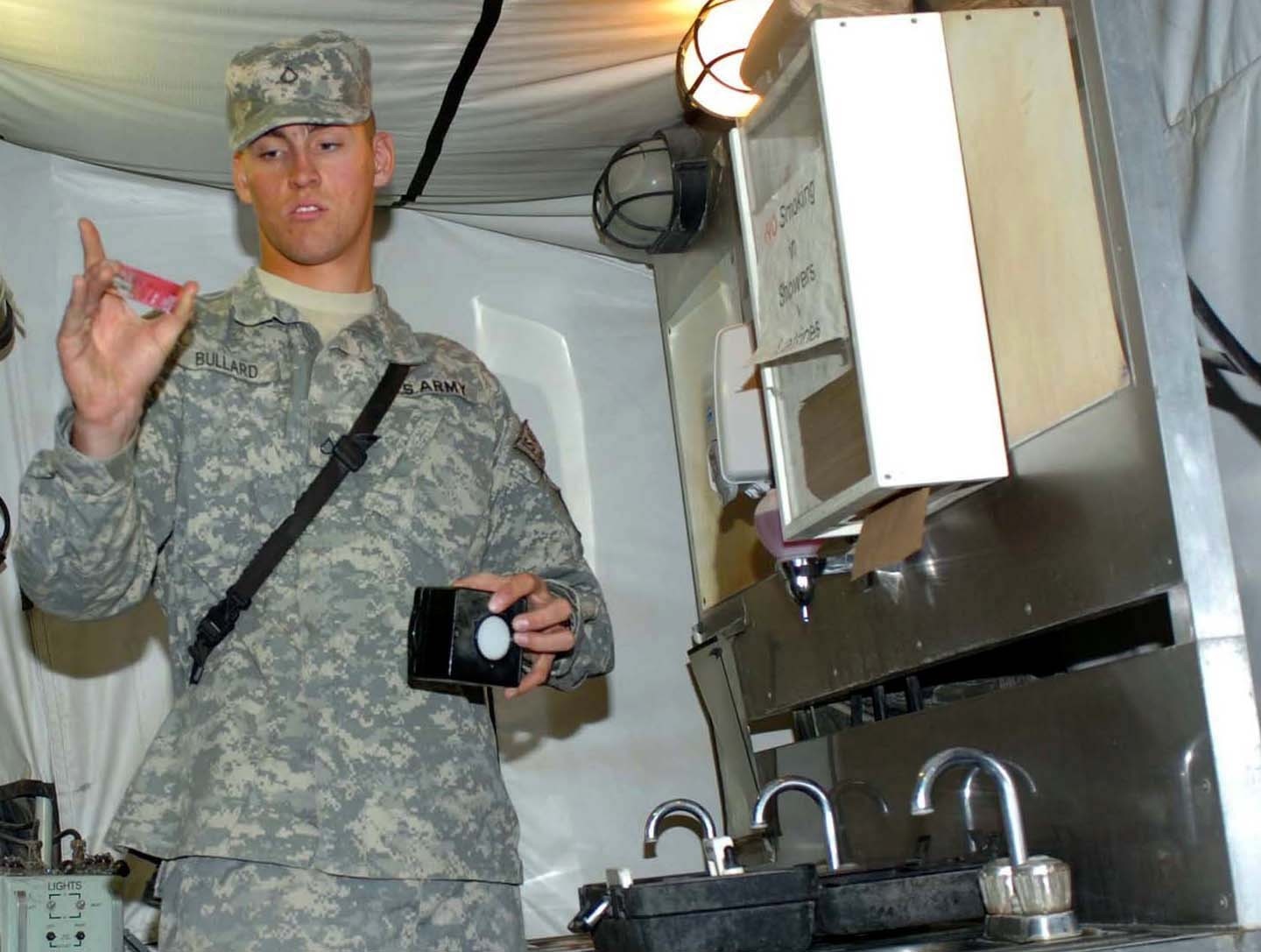JALALABAD AIRFIELD, Afghanistan (Jan. 8, 2008) -- The four-man team of water purification specialists assigned to U.S. Army Europe's Company A, 173rd Brigade Support Battalion is responsible for producing more than 40,000 gallons of water every day for the service members, contractors and civilian employees living here.
The 'water dogs' primary mission is the processing of a daily average 32,500 gallons of non-potable water for personal hygiene, sinks and showers, basic sanitation, toilets and urinals, laundry service, construction and aircraft maintenance. The 'dogs' also crank out another 9,000 gallons of potable water used by the base dining facility to clean and prepare food; purified water for a local coffee shop, and clean water for a new restaurant.
"We provide Soldiers with the water they need to enjoy many of the creature comforts they have back in the rear while they're in this deployed environment, and a lot of those creature comforts are taken for granted when you're on a [forward operating base] like Fenty or Bagram where it's a well-established area," said 1st Lt. Nathan C. Miatech, a Company A platoon leader.
"A lot of the Soldiers forward appreciate what my 'water dogs' do, because they don't have a whole lot of non-potable and potable water," the lieutenant said.
"They have to grab a couple of water bottles and do 'field hygiene,' scrubbing down their essential areas, and that's about all they can do."
The primary water sources on the FOB are two locally constructed wells approximately 140 feet deep. Two submersible pumps bring raw water up to the surface at a rate of 114 gallons per minute and deposit it into 3,000-gallon storage bags called 'onion skins' -- because they look like onions when full -- as well as into a 42,000-gallon brick and mortar storage container designed specifically for non-potable water.
The raw water from the wells is dirty and dangerous.
"The water from the well is coming from out on the economy. It can get you really, really sick," said Pfc. Christopher M. Bullard of A Company. "I think we're doing a great job out here keeping everybody safe; making sure no one is getting sick from the water."
From the 'onion skins' the raw water is turned in to clean potable water with the help of one of the two new $1.2 million, 3,000-gallon-per-hour reverse osmosis water purification Units installed in September that push all the contaminants out of the water. Previously, the 'water dogs' were limited by two 600 gph ROWPUs, and had to work day and night to keep up with the base's water demands.
From the ROWPU the purified water flows into two large round white 5,000-gallon sealed tanks until it's piped to where it's needed. Ten more 5,000-gallon tanks are scheduled to be delivered and in place before spring.
"Were going to have 120,000 gallons of potable water storage on the FOB, and in the near future -- before the 173rd leaves -- you will be taking a shower in potable water. [You] won't have to worry about the signs that say, 'Non-potable water; do not drink or brush your teeth,'" said Sgt. 1st Class Sean L. Carter, a Company A platoon sergeant. "The water you will be showering with is going to be cleaner than the bottled water you drink every day."
Carter said maintaining a proper balance of chlorine in the water is also important.
"Water is a key factor for cooks over at the dining facility, and too much chlorine in the water will brown their vegetables," Carter said. "We go around three times a day, wherever there's running water from any of the pipelines, to check to ensure the water is properly chlorinated -- not too much and not too little. Too much chlorine can cause skin irritation and cause you to break out in a rash or even hives."
Weather poses a challenge for the team, because water runs through the system slower as the temperature drops.
"Sometimes (the weather) brings our production up, and sometimes it brings our production down," said
Sgt. Edward D. Haynes, a Company A section sergeant.
The demand for water at the base has increased over time, and the 'water dogs' say their biggest challenge is a shortage of help. There are only four of them.
"Our water team is doing a heck of a job. It was hard to keep up with water production, but it has gotten a little easier since we have the two new ROWPUs. We still have a lot of work to do as far as improving the site," Bullard said.
"My NCOs have done a great job helping me learn more about my job since I've been out here," he added.
"My 'water dogs' are dedicated. They have yet to complain, 'Hey, we need time off.' They come in seven days a week and work from morning until night ensuring there is no water shortage on the FOB," Carter said.


Social Sharing